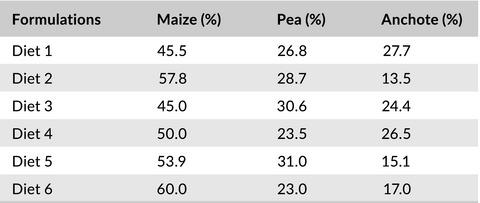当前位置:
X-MOL 学术
›
Food Sci. Nutr.
›
论文详情
Our official English website, www.x-mol.net, welcomes your
feedback! (Note: you will need to create a separate account there.)
Nutritional and antinutritional evaluation of complementary foods formulated from maize, pea, and anchote flours.
Food Science & Nutrition ( IF 3.5 ) Pub Date : 2020-03-20 , DOI: 10.1002/fsn3.1516 Habtamu Fekadu Gemede 1
Food Science & Nutrition ( IF 3.5 ) Pub Date : 2020-03-20 , DOI: 10.1002/fsn3.1516 Habtamu Fekadu Gemede 1
Affiliation

|
This study was aimed to evaluate nutritional and antinutritional contents of complementary foods from locally available and affordable raw materials (maize, pea, and anchote) grown in Western Ethiopia. The six formulated complementary diets analyzed for their proximate, mineral, and antinutritional continents were compared with Codex standards. The mineral ratios and molar ratios of the formulated diets were also evaluated and compared with each standard values. Six formulations were generated by d‐optimal mixture design. The formulated ingredient ranges 45%–61% maize, 23%–31% pea, and 14%–28% anchote. Design‐Expert® 6 (Stat‐Ease) was used to constrain the three components. The formulated diets ranged from 14.92% to 20.99%, 5.95% to 9.94%, 2.75% to 3.41%, and 59.10% to 66.22% of protein, fat, fiber, and utilizable carbohydrate, respectively. Mineral contents (mg/100 g) of the formulated diet ranged from 225.45 to 261.32, 11.48 to 12.61, 2.73 to 3.00, 357.92 to 391.13, 298.55 to 332.63, 252.00 to 278.01, and 44.26 to 51.56 for calcium, iron, zinc, phosphorous, potassium, sodium and magnesium, respectively. The proximate and mineral contents of the formulated diet 5 meet the Codex standards, except the fat contents of the complementary food standards. The molar ratios of the formulated diets in this study were below standard reference and which show the high mineral bioavailability in all the formulated diets. The results of the study revealed that the formulated diets contain very low antinutritional factors and high mineral bioavailability. The paper's findings show that the complementary food formulated from maize, pea, and anchote flours particularly diet 5 may be suitable to alleviate protein energy malnutrition and it can be used as a substitute for the expensive commercial complementary food.
中文翻译:

由玉米、豌豆和凤尾鱼粉配制的辅助食品的营养和抗营养评估。
本研究旨在评估来自埃塞俄比亚西部种植的当地可用且负担得起的原材料(玉米、豌豆和anchote)的补充食品的营养和抗营养成分。将六种配制的补充饮食的近邻、矿物质和抗营养成分与食品法典标准进行了比较。还评估了配制日粮的矿物质比例和摩尔比,并与每个标准值进行比较。通过 d 最优混合物设计生成了六种配方。配方成分范围为 45%–61% 玉米、23%–31% 豌豆和 14%–28% 凤尾鱼。Design‐Expert ® 6 (Stat‐Ease) 用于约束这三个组件。配制的日粮中蛋白质、脂肪、纤维和可利用碳水化合物的含量分别为14.92%至20.99%、5.95%至9.94%、2.75%至3.41%和59.10%至66.22%。配制饲料的矿物质含量(mg/100g)范围为225.45至261.32、11.48至12.61、2.73至3.00、357.92至391.13、298.55至332.63、252.00至278.01和44.26至51.5 6 钙、铁、锌、磷,分别是钾、钠和镁。配制饮食5的粗略含量和矿物质含量均符合食品法典标准,但脂肪含量符合补充食品标准。本研究中配制日粮的摩尔比低于标准参考,这表明所有配制日粮都具有高矿物质生物利用度。研究结果表明,配制的饮食含有非常低的抗营养因子和高矿物质生物利用度。该论文的研究结果表明,由玉米、豌豆和凤尾鱼粉配制的补充食品,特别是饮食5可能适合缓解蛋白质能量营养不良,并且可以用作昂贵的商业补充食品的替代品。
更新日期:2020-03-20
中文翻译:

由玉米、豌豆和凤尾鱼粉配制的辅助食品的营养和抗营养评估。
本研究旨在评估来自埃塞俄比亚西部种植的当地可用且负担得起的原材料(玉米、豌豆和anchote)的补充食品的营养和抗营养成分。将六种配制的补充饮食的近邻、矿物质和抗营养成分与食品法典标准进行了比较。还评估了配制日粮的矿物质比例和摩尔比,并与每个标准值进行比较。通过 d 最优混合物设计生成了六种配方。配方成分范围为 45%–61% 玉米、23%–31% 豌豆和 14%–28% 凤尾鱼。Design‐Expert ® 6 (Stat‐Ease) 用于约束这三个组件。配制的日粮中蛋白质、脂肪、纤维和可利用碳水化合物的含量分别为14.92%至20.99%、5.95%至9.94%、2.75%至3.41%和59.10%至66.22%。配制饲料的矿物质含量(mg/100g)范围为225.45至261.32、11.48至12.61、2.73至3.00、357.92至391.13、298.55至332.63、252.00至278.01和44.26至51.5 6 钙、铁、锌、磷,分别是钾、钠和镁。配制饮食5的粗略含量和矿物质含量均符合食品法典标准,但脂肪含量符合补充食品标准。本研究中配制日粮的摩尔比低于标准参考,这表明所有配制日粮都具有高矿物质生物利用度。研究结果表明,配制的饮食含有非常低的抗营养因子和高矿物质生物利用度。该论文的研究结果表明,由玉米、豌豆和凤尾鱼粉配制的补充食品,特别是饮食5可能适合缓解蛋白质能量营养不良,并且可以用作昂贵的商业补充食品的替代品。









































 京公网安备 11010802027423号
京公网安备 11010802027423号